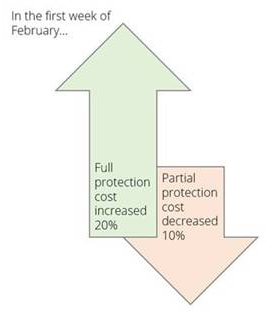Why equity protection should never be too expensive for schemes
From the blog: Equity protection is back in vogue, with falls in markets at the start of the year putting downside protection strategies front of mind.
In one way, this makes perfect sense. But schemes that view equity protection like this typically miss opportunities to use similar tools after the falls have occurred, in order to benefit from any subsequent rebound.
It is easy to think it is too late to implement equity protection when markets have already fallen
It is also often more expensive for schemes to buy downside protection after markets have tumbled, as demand for such solutions jumps.
In fact, many schemes are missing a trick shelling out for expensive downside protection, because costs do not have to be prohibitive as long as schemes buy the right kind of protection for them.
Should you be fully protected?
At the height of market events such as the credit crisis, it is easy to believe the financial world as we know it is at an end.
In 2009, with markets down 50 per cent, banks nationalised across the world, and an unknown debt bomb being passed about in the background, the cost of getting 100 per cent downside protection soared.
What did not soar was the cost of partial protection. This variant of equity protection sees schemes introduce a buffer against some market falls – for example the first 25 per cent decline from current levels – but costs far less than full protection.
The cost of this partial protection is far more stable than full protection. Taking what we saw in 2009 as an example, the cost of protecting against another 25 per cent fall in markets barely moved.
Looking at cost another way – the amount of upside you can target in order to pay for protection – limited protection actually got cheaper while full protection got more expensive.
Put another way, limited protection allowed schemes to benefit from any subsequent rebound in markets, rather than surrender all the potential upside that typically occurs when schemes opt for full protection.
Protection at all times?
The nature of protection strategies are such that investors typically do not consider them when markets have already wobbled or fallen.
It is easy to think it is too late to implement equity protection when markets have already fallen, and conversely it is also easy to ignore it when markets are climbing.
But perhaps the best approach – and one we see more and more schemes adopting over time – is to consider that actually, schemes can never miss the boat with equity protection if they implement partial protection strategies.
For example, if a scheme was to put a partial strategy in place today protecting 25 per cent to the downside, unless markets experienced one of the worst declines on record they would be sufficiently protected, and still have exposure to much of the upside that they need to meet their objectives.
Bespoke protection strategies such as these, which can be tailored for schemes and without implementing full protection, but structured around risk tolerance, should help solve the risk-return conundrum for schemes.
Mark Davies is managing director at River and Mercantile Derivatives
Most Viewed
- What does Labour have in store for the pensions industry?
- LGPS latest: GLIL backers invest £475m for UK infrastructure push
- Dashboard costs rose by 23% in 2023, figures show
- Border to Coast launches UK strategy in major private markets push
- How the pensions industry can better support people with mental health problems


